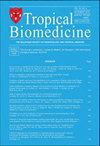马来西亚槟城商品鹌鹑(Coturnix Coturnix)中ST6囊胚菌的自然感染。
IF 0.8
4区 医学
Q4 PARASITOLOGY
引用次数: 0
摘要
囊虫属(Blastocystis sp.)是一种单细胞、厌氧的肠道原生生物,在世界各地的人类和各种动物中都有报道。马来西亚对家禽囊虫感染的研究似乎很少,对鹌鹑囊虫感染的研究也很少。在马来西亚,鹌鹑肉和蛋的消费作为蛋白质的重要来源正迅速受到欢迎。因此,有必要探索马来西亚鹌鹑中胚泡菌的存在,以帮助了解胚泡菌在这一鸟类群体中的存在及其在其传播中的作用。在马来西亚槟城的两个养殖场饲养的90只商业鹌鹑中收集了肠道内容物,这些鹌鹑饲养在一个多层笼子系统中,农场管理适当。Blastocystis sp.的检测方法是在添加10%马血清的改良Jones培养基中培养。形态学研究采用阳性培养物的giemsa染色玻片,囊胚分型采用聚合酶链反应(PCR)。鹌鹑囊虫感染率为17.8%(16/90)。在离体培养基中检测到的细胞最常见的形态为液泡和颗粒状,细胞直径在9.09 ~ 33.33 μm之间。筛选的鹌鹑没有任何明显的胃肠道症状或体征。所有成功测序的分离株均被鉴定为囊虫属ST6,囊虫属一种潜在的人畜共患亚型。本研究认为鹌鹑可能是囊虫亚型人畜共患的宿主。需要更多的研究来了解囊虫感染重症监护家禽的来源以及家禽动物在囊虫传播给人类中的作用。本文章由计算机程序翻译,如有差异,请以英文原文为准。
Natural infection ofBlastocystis ST6 among commercial quails (Coturnix coturnix) in Penang, Malaysia.
Blastocystis sp. is a unicellular, anaerobic intestinal protist regularly reported in humans and various animals worldwide. There seems to be little research on Blastocystis infection in poultry in Malaysia, and none on Blastocystis in quail specifically. In Malaysia, the consumption of quail meat and eggs is rapidly gaining popularity as a significant source of protein. It is, therefore, essential to explore the presence of Blastocystis in Malaysian quails in order to aid in the understanding of Blastocystis in this group of birds and their role in its transmission. Intestinal contents were collected from 90 commercial quails raised on two farms in Penang, Malaysia, in a multi-layer cage system with adequate farm management. Detection of Blastocystis sp. was by cultivation in modified Jones' medium supplemented with 10% horse serum. Giemsa-stained slides made from positive cultures were used for morphological studies whereas Blastocystis subtyping was conducted by using Polymerase Chain Reaction (PCR). A prevalence of 17.8% (16/90) was recorded for Blastocystis sp. in quail in this study. The most common forms detected in the in vitro culture medium were vacuolar and granular forms with cell diameters ranging from 9.09 μm to 33.33 μm. None of the quail birds screened had any visible gastrointestinal symptoms or signs. All successfully sequenced isolates were identified as Blastocystis sp. ST6, one of the potentially zoonotic subtypes of Blastocystis. This study posits that the quail birds may serve as reservoirs of zoonotic subtypes of Blastocystis. More studies are required to understand the source of Blastocystis infection to poultry under intensive care and the role of poultry animals in the transmission of Blastocystis to humans.
求助全文
通过发布文献求助,成功后即可免费获取论文全文。
去求助
来源期刊

Tropical biomedicine
医学-寄生虫学
CiteScore
1.60
自引率
0.00%
发文量
63
审稿时长
6-12 weeks
期刊介绍:
The Society publishes the Journal – Tropical Biomedicine, 4 issues yearly. It was first started in 1984. The journal is now abstracted / indexed by Medline, ISI Thompson, CAB International, Zoological Abstracts, SCOPUS. It is available free on the MSPTM website. Members may submit articles on Parasitology, Tropical Medicine and other related subjects for publication in the journal subject to scrutiny by referees. There is a charge of US$200 per manuscript. However, charges will be waived if the first author or corresponding author are members of MSPTM of at least three (3) years'' standing.
 求助内容:
求助内容: 应助结果提醒方式:
应助结果提醒方式:


